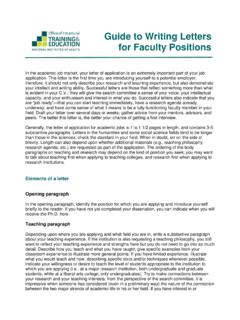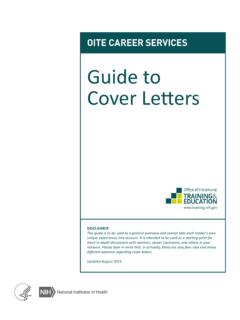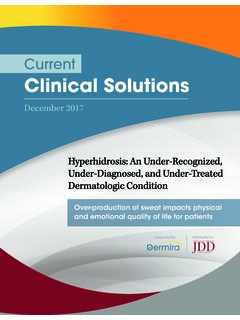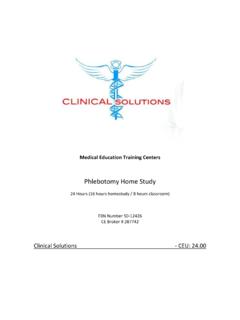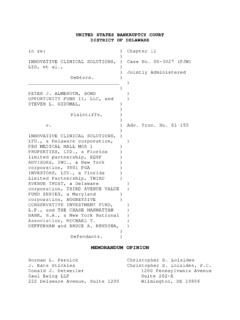Transcription of Laboratory Math II: Solutions and Dilutions
1 Slide 1 Laboratory math II: Solutions and DilutionsPhilip Ryan, PhDPost-Doctoral FellowNational Cancer Institute, NIH Welcome to the National Institutes of Health, Office of Intramural Training & Education s Webinar on Laboratory math II: Solutions and Dilutions . This Webinar is intended to give a brief introduction into the mathematics of making Solutions commonly used in a research setting. While you may already make Solutions in the lab by following recipes, we hope this Webinar will help you understand the concepts involved so that you can calculate how to make any solution. Slide 2 Solutions A solution is a homogenous mixture of two or more substances. Can be in any form of matter: solid, liquid or gas Solutions are essential in most Laboratory -based biomedical research Examples: buffers, reaction mixtures, cell culture media, cell lysates, etc. A textbook definition of a solution is a homogenous mixture of two or more substances.
2 These mixtures can be in any form of matter, however for this Webinar we are going to focus exclusively on liquid Solutions . In a Laboratory setting, Solutions are an essential part of research. There is a reason that bench research is often referred to as wet research. Most biochemical reactions occur in liquid Solutions . This should help explain why dehydration is such a life threatening ailment! Without water, the body is unable to perform many of the biochemical functions necessary to survive. In the Laboratory , Solutions are everywhere. Buffers, reaction mixtures, cell culture media, cell lysates, liquid acids and bases are all examples of Solutions commonly used in the lab. Slide 3 Concentration The concentration of a solution is how much of the solute is present per unit of volume It can be recorded and reported in multiple ways depending on the solution and the scientist Molarity Moles/Liter; mols/L (M) Mass/volume grams/L; g/L or mg/ml Normality moles of active ions/L (N) We talk about Solutions in terms of concentrations, how much of each substance, or solute, the solution contains.
3 Concentration can be recorded and reported in many different ways depending on the solution, the scientist and what the solution is being used for. Let s review a few of the common ways of reporting concentration. Molarity is used to report molecules of a substance per unit volume. Specifically, molarity is the number of moles of a substance per liter of the solution. It is reported in moles per liter or with a capital M for molar. Mass per unit volume is often used to report the concentration of proteins and other complex substances with molarities that are not easily determined. So, the concentration of a complex solution of proteins often is reported as grams per liter. Normality is like molarity, but is used for ionic Solutions to more accurately represent their ionic strength. A single molecule of an ionic compound may (when in solution) separate into individual charged particles.
4 For example: NaCl in solution consists of positive charged sodium ions and negatively charged chloride ions. What is relevant is solute particles per unit volume, or ions per volume. So, normality is the number of moles of active ions per liter in a solution. Acid and base concentrations are often expressed in normality. Slide 4 Making a Solution: What You Need to KnowTo make a solution from a solid solute (that which is being dissolved) and a liquid solvent (that which is being used to dissolve the solute) you will need to know: The desired concentration What units you will be reporting the concentration in If molarity or normality, the molecular or formula weight of the substance (solute) The desired volume Before you can make a solution, you need to know a few things. In this case, we will be looking at how to make a solution from a solid substance or solute being dissolved in a liquid, or solvent.
5 To do this, you need to know: the desired concentration of the completed solution. That means, how much of your substance per unit volume do you want when you are finished making your solution? You will also need to know what units you will be reporting the concentration in. If you will be reporting in molarity or normality, you will need to know the molecular or formula weight of the substance. That is to say, you need to know how many grams of the substance are in a mole. You need this information because we cannot readily measure the number of moles of a substance, but we can measure the mass. So, we use the mass and the molecular weight to determine moles. The molecular weight is determined by the elemental composition of the compound and is usually listed on the container the solid solute is stored in. You will also need to know the desired volume of the finished solution.
6 Slide 5 Making a Solution How to make 1L of a 5M solution of a substance with a molecular weight of 75 g/mol. How many grams of the solute should we weight out? Approach: figure out how many moles we need, then convert to grams. CV = Total amount 5 mol/L x 1 L = 5 mol Grams = moles x grams/mol (MW) 5 mol x 75 g/mol = 375 g Weigh out 375 g and bring the volume to 1L with solvent Let s take a look at a simple example. How would we make one liter of a five molar solution of a substance with a molecular weight of 75 grams per mole? The first thing to determine is: what don t we know? We know the volume, the molarity we want and the molecular weight. What we need to know is how many grams of the substance we need to measure out. So our approach is to first determine how many moles we need of the substance and then use the molecular weight to determine how many grams we need to weigh out.
7 It is important to note that concentration x volume (or CV) is equal to the total amount of substance. A five molar solution means we have five moles per liter. And we want a total of one liter. If we multiply five moles per liter times the total volume of one liter, we get our total number of moles needed for our solution, which is five. To determine the number of grams we need, we multiply the number of moles by the molecular weight, which is grams per mole. We know that the molecular weight of our substance is 75 grams per mole and that we need 5 moles. So, we can multiply the five moles needed by 75 grams per mole and we can solve that we need 375 grams of the substance. So, we can weigh out the 375 grams of the substance and then bring the volume to one 1 liter with solvent. It is important to note that you do NOT add one liter of solvent to the 375 grams of the substance.
8 The dry substance has a volume as well, and if you add a liter of solvent, your total volume will be greater than one liter and your concentration will be wrong. Slide 6 Making a Complex Solution Solutions often have more than just one solute. To make a complex solution with two or more solid solutes, treat each solute individually 5 liters of 50mM NaCl, 10mM Tris-HCl solution Determine what mass of NaCl you need Determine what mass of Tris-HCl you need Add both to container and bring to volume with water Solutions in a research setting often have more than just one solute component. Complex Solutions are those that contain two or more chemical compounds in addition to the solvent. To make a complex solution with solid solutes, you treat each solute individually when determining the mass of that compound to add to the solution. For example, to make a five liter solution of 50 millimolar NaCl and ten millimolar tris-HCl, you would first determine the mass of NaCl that you need.
9 Then, you would determine the mass of Tris-HCl you need. You would weigh out both individually, add them to the desired container capable of holding 5 liters of liquid and then you would bring the solution to five liters of volume with water while mixing. Slide 7 Making a Complex Solution Determine how much NaCl you need 50mM = 50mmol/L 5L x 50mmol/L = 250mmols x = = Note: Significant digits are determined by the scale you will measure the NaCl on Determine how much Tris-HCl you need ( ) 10mM = 10mmol/L 5L x 10mmol/L = 50mmol x = = Add to a container and bring volume to 5L with water Let s go ahead and work out the arithmetic for this solution. First, we need to determine the mass of NaCl that we will need. We know we need the final concentration to be fifty millimolar, which means we will need fifty millimoles of NaCl per liter of solution. Remember that CV = total amount.
10 So, we multiply five liters by fifty millimole per liter. The liters cancel out and we now know that we need 250 millimoles of NaCl. We also know that we can convert 250 millimoles into moles by dividing by ten to the negative three. This lets us know that we need two point five times ten to the negative one mols of NaCl. We can then multiply this by the molecular weight of NaCl, which is grams per mole. The moles cancel out and we get times ten to the negative one grams or grams of NaCl. Note that the significant digits will be determined by the scale you will use to weigh out the compounds. Next you determine how much Tris-HCl you need. The molecular weight of Tris-HCl is grams per mole. Can you work out how many grams we will need for five liters of a ten millimolar solution? Again determine how much mass you need to weigh out by multiplying concentration by volume.


